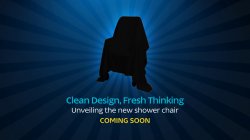Support
The amount of support a client needs will affect whether a lift or hoist is most suitable. Generally speaking, users with limited mobility should opt for hoists since these raise you high enough that you don’t need to lift your legs over the bath rim. The GoLift ceiling hoist, for example, is a compact, easy-to-install system that simplifies routine transfers – its track profiles include bends, XY room-cover and auto-lock gates, so users get the right coverage and support throughout the bathroom environment.
When specifying a bath hoist, the first support consideration is the seat back. Some lifts, like band lifts, don’t have backs – making them unsuitable for users who can’t support themselves. Others come with adjustable backs that can be angled, allowing users to recline comfortably.


Another consideration is seat size. If the seat is too small, users will sit awkwardly and won’t get enough postural support. If the seat is the wrong shape or uncomfortable, then they’re likely to sit too far forward and lack support.
If you have a client with specific postural requirements, then it’s worth looking at equipment options that allow you to fit custom seating to the standard frame. We offer this with the Autolift Bath Hoist – this can make a big difference when it comes to effective cleaning, comfort and postural support.
Ease of use and durability
As with all care equipment, it’s important to consider ease of use. If the user has a reasonable degree of independence, then you need to look at how simple it is to get in and out of the lift seat. If they rely more heavily on a carer, then you need to think about the ergonomics associated with assistance.
It’s also important to remember that bathrooms are humid environments, which means certain metals will rust and corrode. Look for equipment with stainless steel components – they’ll last longer and deliver better value.
The bathroom
Consider how the equipment will position the user in the bath and look for options that maximise space. If the bath is short (for example, a studio bath rather than a standard size) or in a corner, then the seat’s position may mean the user is squashed down the tub. This creates issues around comfort and access.
You should also consider structural issues. How much weight can the bathroom floor bear? Depending on the construction, you may need a lift that can be fixed to the wall as well as the floor to distribute the user’s weight safely and effectively. Not all equipment allows this, so it’s worth having the product adviser review the structure before choosing what to prescribe.
For more advice about prescribing bath hoists – or to learn more about the Autolift and our associated support – contact us on sales@wealdenrehab.com or at 0845 658 8411.

Latest Blog Posts
Seasonal opening times 2025/26
2025 Holiday Season Update - Our team are here for you but we will be taking a break between the 24th December and 2nd January 2025.

New Shower Chair Innovation
Experience Wealden Rehab’s new shower chair innovation at the OT Show 2025

Responsive Care Equipment Supplier Across the UK
Supporting hospitals and care providers in unsettling times ...

NAEP Conference 2025
Meeting Occupational Therapists, Commissioners and Exploring Bariatric and Paediatric Solutions

Our Seasonal opening times 2024/25
Our team are here for you but we will be taking a break between the 24th December and 2nd January 2025.

Can a RAZ shower chair rust?
Get an in-depth look at the RAZ shower chair range and the protective features that make them built to last



